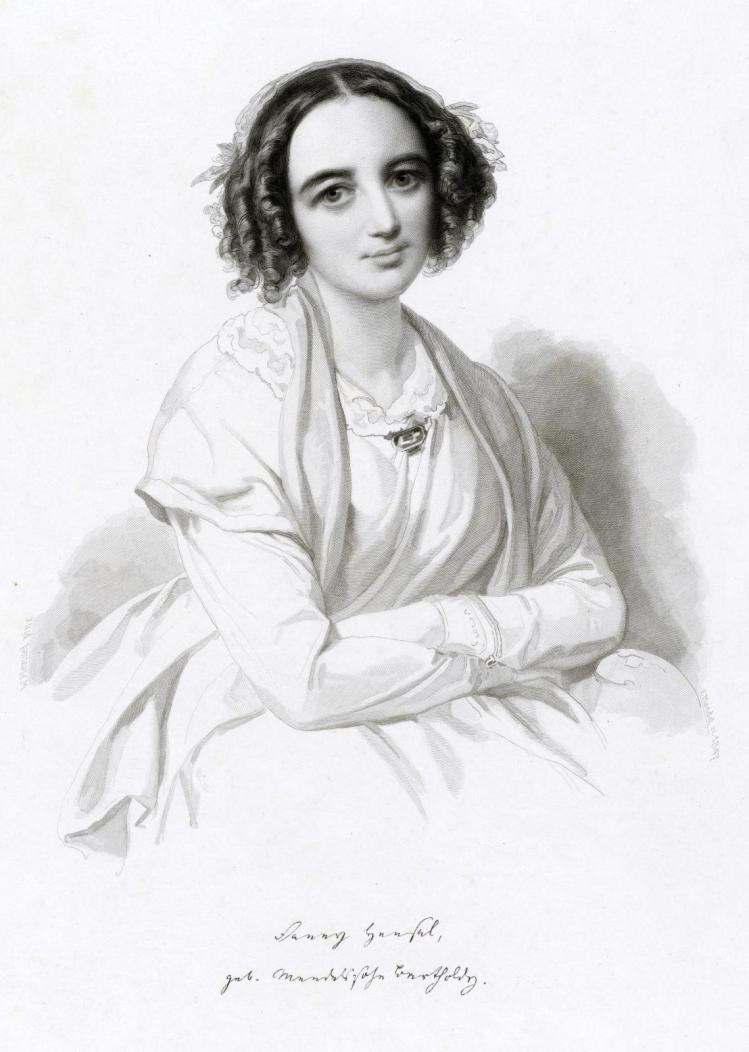
Berlin, 1828. A promising young composer, born to a distinguished family, writes the title at the top of a newly completed piano sonata: Ostersonate (Easter Sonata). It is an impressive accomplishment from an impressive talent, conveying in four movements a notable command of the form and a daring originality as it whisks the listener through an aural representation of the Passion. Evoking the emotion of Beethoven and the precision of Bach, Easter Sonata goes beyond mere imitation to boldly convey both the suffering of the Crucifixion and the gentle hope of the Resurrection. On the title page, the composer signs, “F. Mendelssohn.”
Even casual fans of classical music will recognize it. It is the name behind the ubiquitous “Wedding March,” the beloved melody of “Hark! The Herald Angels Sing,” and large-scale masterpieces like the Hebrides overture, the oratorios Saint Paul and Elijah, the “Scottish” and “Italian” symphonies, and the eerily beautiful Violin Concerto in E Minor. That is, if the F. Mendelssohn you’re thinking of is Felix Mendelssohn, the boy genius whose star power surpassed that of the young Mozart and who grew up to be a groundbreaking composer and conductor.
But there was another F. Mendelssohn; in fact, the first. Three years older, Fanny Mendelssohn was Felix’s beloved and “equally gifted sister,” in the words of Goethe, who admired them both. She, too, was a prolific composer, leaving behind more than 450 known works. Yet unlike her brother, and like most women at the time, she was not allowed to pursue music as a profession. Nevertheless, it was she who, at age twenty-two, wrote Easter Sonata, a sophisticated piece that might have enjoyed a long life of performance had it not been lost for almost 150 years.
At the time of its rediscovery—in a French bookshop in 1970—it was assumed to be Felix’s composition. A masterpiece bearing all his supposed trademarks, it was too “ambitious” and even “violent” to have been written by Fanny, then considered little more than a supporting character in her brother’s biography. But the truth broke the surface forty years later when a graduate student studied the manuscript and declared definitively that Easter Sonata, in all its “masculine” glory, was written by Fanny in her own handwriting. It finally premiered in her name at a small concert in 2012, followed by a large-scale performance on International Women’s Day in 2017, with her great-great-great-granddaughter Sheila Hayman in attendance. Hayman has since gone on to direct a groundbreaking 2023 documentary entitled Fanny: The Other Mendelssohn.
That this tale of misattribution, female erasure, and belated recognition should attend a sonata named for Easter is perhaps too perfect. Easter brings to light the central role of women in the Paschal Mystery and, by extension, the Church itself. Women are everywhere in the Passion narrative: outside the high priest’s house, on the way of the cross, at the Crucifixion, at the tomb. Mary Magdalene, the first witness of the risen Christ, became in those early hours of Easter morning, to quote Fr. James Martin, “the entire Church on Earth.” Yet how often do we find these women overlooked? The famous race between John and Peter to get to the tomb often gets more attention than the revelatory appearance of Jesus to a woman. Fanny Mendelssohn—who, through her music, bore her own witness to the Resurrection—would know a thing or two about that.
Fanny Mendelssohn-Bartholdy was born in Hamburg on November 14, 1805. Her father, Abraham, was a successful banker and son of the Jewish philosopher Moses Mendelssohn, whose ideas fostered the Jewish Enlightenment of the eighteenth and nineteenth centuries. Still, Abraham and his wife, Lea, chose to baptize their family into the Lutheran faith and adopt the surname “Bartholdy” in an attempt to avoid the mistreatment leveled at Prussia’s Jewish population. Both Fanny and Felix would later admit to disliking the name, and evidence suggests they were openly proud of their Jewish roots.
Thanks to their parents’ wealth and Enlightenment values, Fanny and her siblings received the best private education available, including rigorous musical training. From an early age, it was clear that Fanny was unusually gifted; at fourteen, she could play from memory all twenty-four preludes from Bach’s Well-Tempered Clavier, and she began composing her own pieces perhaps even earlier. Several who saw her play, including the esteemed composer and educator Carl Friedrich Zelter, believed her talents exceeded her brother’s.
The two child prodigies were each other’s muses, chief counsel, and best friends. Fanny and Felix supported each other’s work even as it became apparent that only the male “F. Mendelssohn” would pursue music professionally. Abraham was clear when he wrote to the teenaged Fanny: “Music will perhaps become [Felix’s] profession, while for you it can and must be only an ornament.” A year after Fanny penned Easter Sonata he instructed her to “prepare more earnestly and eagerly for your calling, the only calling of a young woman—I mean the state of a housewife.”
And so brother and sister advanced dutifully toward their callings: Felix to his musical career and Fanny to a household of her own. She married a painter, Wilhelm Hensel; had a son, Sebastian; and suffered at least two miscarriages. She wrote music as her household duties allowed—which, as any artist who is also an overburdened mother will tell you, was sometimes not at all—and she remained Felix’s closest musical confidante. “You really know what God intended when he invented music,” he wrote to her.
Still, Felix echoed his father’s opinion that a woman of Fanny’s status should not be a professional musician. Though he was willing to publish some of her pieces under his name, he believed Fanny was “too much all that a woman ought to be” to publish work under her own. “She regulates her house, and neither thinks of the public nor of the musical world, nor even of music at all, until her first duties are fulfilled,” he wrote to their mother. “Publishing would only disturb her in these, and I cannot say that I approve of it.”
And so she did not. For all her musical genius, Fanny Mendelssohn was not a doorbuster. When writing about her music, she often reveals a lack of confidence and feelings of inadequacy. And she responded sensitively to any criticism she received from Felix; after he disparaged her first string quartet, she never attempted the genre again.
Yet with age came some small measure of defiance. After a transformative year of travel with her family in Italy, a burst of creative energy led to several of Fanny’s premier compositional achievements, including Das Jahr, a cycle of twelve piano pieces corresponding to each month of the year. Praise from fellow musicians increased Fanny’s confidence by leaps and bounds, enough for her to finally break with Felix’s prescription and publish under her own name.
But in 1847, less than a year after she published her first collections, Fanny died of a stroke. She was only forty-one years old. Felix, utterly distraught, survived six months without her before succumbing to his own series of strokes at the age of thirty-eight. He lived just long enough to compose his “Requiem for Fanny,” a string quartet raw and full of agony, marking a radical departure from a body of work known (and sometimes scoffed at) for its restraint.
What the world of music lost in the siblings’ untimely deaths cannot be overstated. Yet, after an outpouring of grief for Europe’s most famous composer, it wasn’t long before the roiling anti-Semitism of the nineteenth century rose up in force to puncture Felix’s reputation. His most ferocious detractor was Richard Wagner, whose scathing 1898 essay, “Jewishness in Music,” lampooned Mendelssohn for “show[ing] us that a Jew can possess the richest measure of specific talents, the most refined and varied culture...without even once through all these advantages being able to bring forth in us that profound, heart-and-soul searching effect we expect from music.” A few decades later, Wagner devotee Adolf Hitler banned Mendelssohn’s music and ordered statues of him destroyed. As the younger F. Mendelssohn’s legacy was forcibly repressed, the elder seemed consigned to oblivion.
But by the latter half of the twentieth century, Felix’s legacy was poised for a resurrection. His music had caught the notice of scholars and conductors who questioned Mendelssohn’s fall from grace and began to reexamine, in the words of Jürgen Ernst, “the first European superstar.” Hundreds of pieces that had been lost were rediscovered and recorded for the first time. Among them was Easter Sonata, first recorded—under Felix’s name—by pianist Éric Heidsieck in 1972.
Even then, some wondered if the “F. Mendelssohn” on the title page might be Fanny. But the idea was not pursued seriously until 2010, when Duke doctoral student Angela R. Mace obtained permission to examine the manuscript. She compared it to letters, diary entries, and some of Fanny’s handwritten compositions, which, thanks to new interest in female composers, had begun to see the light of day. From there, she determined that Easter Sonata not only matched Fanny’s handwriting but was cut out of her songbook. The news made headlines around the world, and two years later, Easter Sonata finally premiered under her name.
As her compositions finally enter the mainstream, Fanny Mendelssohn Hensel is at last enjoying a resurrection of her own. In 2022, music scholar Tim Parker-Langston published the first of three landmark volumes of Fanny’s songs for voice, many of which had never been published or recorded before. The same year, world-renowned pianist Isata Kanneh-Mason began including Easter Sonata in several of her concerts.
The stories of Fanny and Felix Mendelssohn are intertwined; to attempt to sever that relationship would mar the truth of who each of them was. The Easter story, too, is not complete without Peter and John and Thomas, nor without Mary, Mary, Martha, Veronica, and the many unnamed women present throughout Jesus’ ministry and the days of the early Church.
Like Fanny, these women matter not only because of the supporting role they played to the men around them. Doorbusters or not, they made rich contributions of their own to the spiritual and cultural landscapes they were shaping. From the revolutionary Magnificat of Mary to the love poetry of Ruth and Naomi to the revelations of Julian of Norwich to the music of Hildegard von Bingen, women have shaped Christianity through their words, prayers, poems, and songs.
We do them—and ourselves—a grave injustice when we do not give them equal weight. Easter is the ideal time to give thanks for the faithful, creative witness of women. And for those of us who are women, it is the ideal time to remember that our gifts are meant to be shared even in a world, and a Church, that hesitates to receive them. Through the examples of Mary, Martha, Veronica—and Fanny Mendelssohn—may we honor the call to share our song.
Please email comments to [email protected] and join the conversation on our Facebook page.
Share
Previous Story
Rather than Void
Next Story
A Paschal Mystery


